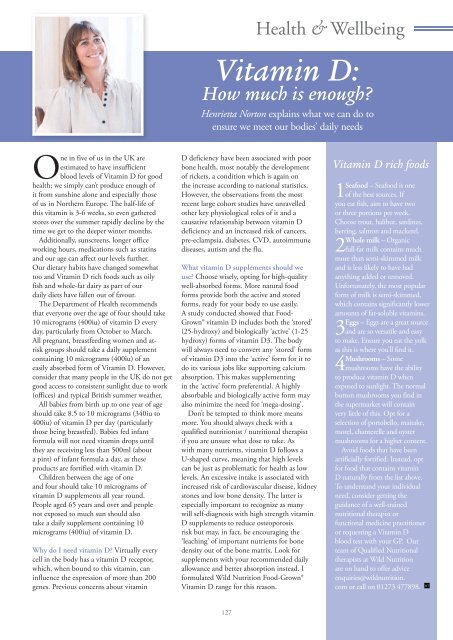Wealden Times | WT213 | November 2019 | Gift supplement inside
Wealden Times - The lifestyle magazine for the Weald
Wealden Times - The lifestyle magazine for the Weald
You also want an ePaper? Increase the reach of your titles
YUMPU automatically turns print PDFs into web optimized ePapers that Google loves.
Health & Wellbeing<br />
Vitamin D:<br />
How much is enough?<br />
Henrietta Norton explains what we can do to<br />
ensure we meet our bodies’ daily needs<br />
One in five of us in the UK are<br />
estimated to have insufficient<br />
blood levels of Vitamin D for good<br />
health; we simply can’t produce enough of<br />
it from sunshine alone and especially those<br />
of us in Northern Europe. The half-life of<br />
this vitamin is 3-6 weeks, so even gathered<br />
stores over the summer rapidly decline by the<br />
time we get to the deeper winter months.<br />
Additionally, sunscreens, longer office<br />
working hours, medications such as statins<br />
and our age can affect our levels further.<br />
Our dietary habits have changed somewhat<br />
too and Vitamin D rich foods such as oily<br />
fish and whole-fat dairy as part of our<br />
daily diets have fallen out of favour.<br />
The Department of Health recommends<br />
that everyone over the age of four should take<br />
10 micrograms (400iu) of vitamin D every<br />
day, particularly from October to March.<br />
All pregnant, breastfeeding women and atrisk<br />
groups should take a daily <strong>supplement</strong><br />
containing 10 micrograms (400iu) of an<br />
easily absorbed form of Vitamin D. However,<br />
consider that many people in the UK do not get<br />
good access to consistent sunlight due to work<br />
(offices) and typical British summer weather.<br />
All babies from birth up to one year of age<br />
should take 8.5 to 10 micrograms (340iu to<br />
400iu) of vitamin D per day (particularly<br />
those being breastfed). Babies fed infant<br />
formula will not need vitamin drops until<br />
they are receiving less than 500ml (about<br />
a pint) of infant formula a day, as these<br />
products are fortified with vitamin D.<br />
Children between the age of one<br />
and four should take 10 micrograms of<br />
vitamin D <strong>supplement</strong>s all year round.<br />
People aged 65 years and over and people<br />
not exposed to much sun should also<br />
take a daily <strong>supplement</strong> containing 10<br />
micrograms (400iu) of vitamin D.<br />
Why do I need vitamin D? Virtually every<br />
cell in the body has a vitamin D receptor,<br />
which, when bound to this vitamin, can<br />
influence the expression of more than 200<br />
genes. Previous concerns about vitamin<br />
D deficiency have been associated with poor<br />
bone health, most notably the development<br />
of rickets, a condition which is again on<br />
the increase according to national statistics.<br />
However, the observations from the most<br />
recent large cohort studies have unravelled<br />
other key physiological roles of it and a<br />
causative relationship between vitamin D<br />
deficiency and an increased risk of cancers,<br />
pre-eclampsia, diabetes, CVD, autoimmune<br />
diseases, autism and the flu.<br />
What vitamin D <strong>supplement</strong>s should we<br />
use? Choose wisely, opting for high-quality<br />
well-absorbed forms. More natural food<br />
forms provide both the active and stored<br />
forms, ready for your body to use easily.<br />
A study conducted showed that Food-<br />
Grown® vitamin D includes both the ‘stored’<br />
(25-hydroxy) and biologically ‘active’ (1-25<br />
hydroxy) forms of vitamin D3. The body<br />
will always need to convert any ‘stored’ form<br />
of vitamin D3 into the ‘active’ form for it to<br />
do its various jobs like supporting calcium<br />
absorption. This makes <strong>supplement</strong>ing<br />
in the ‘active’ form preferential. A highly<br />
absorbable and biologically active form may<br />
also minimize the need for ‘mega-dosing’.<br />
Don’t be tempted to think more means<br />
more. You should always check with a<br />
qualified nutritionist / nutritional therapist<br />
if you are unsure what dose to take. As<br />
with many nutrients, vitamin D follows a<br />
U-shaped curve, meaning that high levels<br />
can be just as problematic for health as low<br />
levels. An excessive intake is associated with<br />
increased risk of cardiovascular disease, kidney<br />
stones and low bone density. The latter is<br />
especially important to recognize as many<br />
will self-diagnosis with high strength vitamin<br />
D <strong>supplement</strong>s to reduce osteoporosis<br />
risk but may, in fact, be encouraging the<br />
‘leaching’ of important nutrients for bone<br />
density out of the bone matrix. Look for<br />
<strong>supplement</strong>s with your recommended daily<br />
allowance and better absorption instead. I<br />
formulated Wild Nutrition Food-Grown®<br />
Vitamin D range for this reason.<br />
Vitamin D rich foods<br />
Seafood – Seafood is one<br />
1 of the best sources. If<br />
you eat fish, aim to have two<br />
or three portions per week.<br />
Choose trout, halibut, sardines,<br />
herring, salmon and mackerel.<br />
2Whole milk – Organic<br />
full-fat milk contains much<br />
more than semi-skimmed milk<br />
and is less likely to have had<br />
anything added or removed.<br />
Unfortunately, the most popular<br />
form of milk is semi-skimmed,<br />
which contains significantly lower<br />
amounts of fat-soluble vitamins.<br />
3Eggs – Eggs are a great source<br />
and are so versatile and easy<br />
to make. Ensure you eat the yolk<br />
as this is where you’ll find it.<br />
Mushrooms – Some<br />
4 mushrooms have the ability<br />
to produce vitamin D when<br />
exposed to sunlight. The normal<br />
button mushrooms you find in<br />
the supermarket will contain<br />
very little of this. Opt for a<br />
selection of portobello, maitake,<br />
morel, chanterelle and oyster<br />
mushrooms for a higher content.<br />
Avoid foods that have been<br />
artificially fortified. Instead, opt<br />
for food that contains vitamin<br />
D naturally from the list above.<br />
To understand your individual<br />
need, consider getting the<br />
guidance of a well-trained<br />
nutritional therapist or<br />
functional medicine practitioner<br />
or requesting a Vitamin D<br />
blood test with your GP. Our<br />
team of Qualified Nutritional<br />
therapists at Wild Nutrition<br />
are on hand to offer advice<br />
enquiries@wildnutrition.<br />
com or call on 01273 477898.<br />
127


















